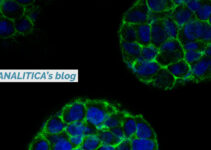Why are biosensors a promising challenge for researchers worldwide?
Biosensor technology has attracted increasing interest in the scientific community because it is an innovative analytical method for a variety of applications in several fields such as healthcare, food and environmental issues. Biosensors can be a revolution for monitoring methods: in real-time, online, and in situ. Indeed, they can be developed as points of care tests (POCT), as wearable sensors, and can be used in combination with mobile devices, thereby representing the new avant-garde systems.
What are biosensors?
Biosensors are composed by two elements: a bioreceptor and a transducer.
The bioreceptor is a molecule that recognizes a specific target. Instead, the transducer converts a biological signal, due to the binding between the bioreceptor and target, into a physical-chemical measurable signal.
Antibodies, aptamers, molecularly imprinted polymer (MIP) and DNA probes are just some examples of bioreceptors that can be chosen to build the biosensor and they depend on the target to be detected: a tissue, cell, protein, enzyme or nucleic acid.
There are different kinds of transducers, such as optical, electrochemical, and acoustic. Therefore, it is possible to measure the changing of wavelength (nm), electron exchange (current), and acoustic waves (Hz) due to the interaction between the target and the bioreceptor. The change in the signal is proportional to the amount of bound targets, thus the biosensor is also a quantitative system.
- Optical biosensors can be mainly based on the following phenomena: surface plasmon resonance (SPR) or localized surface plasmon resonance (LSPR). The target and bioreceptor interaction on a metal film or nanostructure cause a change in the index of refraction by the resonance conditions of the surface plasmon waves.
- Electrochemical biosensors employ amperometric, potentiometric, impedimetric and conductimetric detection principles. They monitor changes in the electrical current caused by an electrochemical reaction between the target and electrode surface.
- Acoustic biosensors are quartz crystal microbalance (QCM) that relies on a voltage being applied to the crystal causing it to oscillate at a specific frequency. The changing deposition mass (target) on the transducer is measured by monitoring the variation in the frequency of the oscillating crystal.
Thanks to the opportunity to develop biosensors according to our needs using several tailor-made elements built or selected ad hoc, these devices represent a powerful alternative to conventional detection methods. Other advantages are ease of use, fast response, wide linear range, reproducibility, high analytical performance, long stability and can be label-free.
So, stay tuned because this article wants to be just the begging of a narrative fil rouge to discover the current biosensor applications in the biomedical field with the future perspective for revolutionizing the diagnostic world!
Author: Dr. Priya Vizzini



